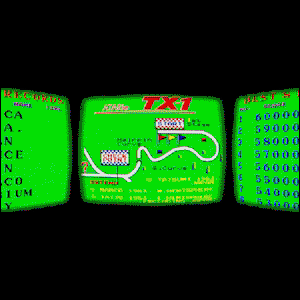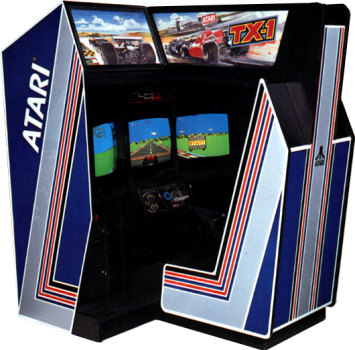 Atari releases the arcade video game TX-1, licensed from Namco (which itself licensed the game from another Japanese manufacturer). This game is available only in a massive “cockpit” big enough to accommodate three CRT screens.
Atari releases the arcade video game TX-1, licensed from Namco (which itself licensed the game from another Japanese manufacturer). This game is available only in a massive “cockpit” big enough to accommodate three CRT screens. ![]()
The Game: Prepare once again to qualify! Players are at the controls of a race car, this time with a nearly-180-degree view – but don’t be too distracted by the scenery and keep your eyes on the road, because the wheel and the pedals are sensitive, and keeping a handle on what gear the car is in is more critical than ever. Crashing into cars, trees, or billboards costs precious time; the only way to extend one’s time in the race is to pass the other racers in one piece. Reaching the end of a particular course gives players the option to choose their own adventure, picking the next course and influencing the difficulty of clearing the next outcome. (Atari [under sublicense from Namco / under license from Tatsumi], 1984)
 Memories: I only ever saw this machine in person once, which was a testament to the financial health of the arcade in which it was taking up a decent chunk of the floor plan. Atari charged a premium for the game upon release – $5,499 – so players had to have put a lot of quarters into existing Pole Position and Pole Position II machines to make it possible for their local arcade operators to graduate to the far more finicky TX-1. The Pole Position connection – Atari marketed this as the third in that game’s lineage – was strictly an invention of the marketing department, as TX-1 did not originate from Namco, but from another Japanese game maker, Tatsumi. Namco, perhaps with an eye on making its own inroads in the North American market, snagged distribution rights for the western hemisphere; Taito grabbed the eastern-hemisphere-outside-of-Japan license. Namco then sublicensed the game to Atari, and thus the legend of TX-1 being related to Pole Position in any way was born. (Tatsumi gamely added logos for Namco, Taito, and Atari to the billboards that go zipping past, as well as an Atari building in the distance; if you’ve got buyers eager to license the game, might as well keep them happy.)
Memories: I only ever saw this machine in person once, which was a testament to the financial health of the arcade in which it was taking up a decent chunk of the floor plan. Atari charged a premium for the game upon release – $5,499 – so players had to have put a lot of quarters into existing Pole Position and Pole Position II machines to make it possible for their local arcade operators to graduate to the far more finicky TX-1. The Pole Position connection – Atari marketed this as the third in that game’s lineage – was strictly an invention of the marketing department, as TX-1 did not originate from Namco, but from another Japanese game maker, Tatsumi. Namco, perhaps with an eye on making its own inroads in the North American market, snagged distribution rights for the western hemisphere; Taito grabbed the eastern-hemisphere-outside-of-Japan license. Namco then sublicensed the game to Atari, and thus the legend of TX-1 being related to Pole Position in any way was born. (Tatsumi gamely added logos for Namco, Taito, and Atari to the billboards that go zipping past, as well as an Atari building in the distance; if you’ve got buyers eager to license the game, might as well keep them happy.)

Driven by two Intel 8086 chips and three Z80 chips, TX-1 had to have enough processing power to generate three monitors’ worth of scenery in real time, quite a feat in the days before widescreen displays and long before multiple-monitor setups became common. These days, of course, one could play the whole game on a single extra-wide curved monitor and get something not unlike the same effect. In that regard, TX-1 – more by accident than by design – has aged better than some of its arcade siblings. The major difference is in the sensitivity of the controls; the steering wheel and pedals require a delicate touch, and the steering column boasts one of the first force-feedback systems ever in a racing game: when players crashed, they got to feel it. TX-1 was intended to be an improvement upon Pole Position, not a sequel to it. Where only a year earlier arcade operators amortized their investment into laserdisc-driven games by frequently charging 50 cents per game, it wasn’t uncommon to find them charging a full dollar to play TX-1.

But with a huge cabinet that took up the amount of space on a floor plan as three upright cabinets, they had to find a way to make TX-1 pay for itself as quickly as possible. Atari eventually knocked a thousand dollars of the price. TX-1 took up a lot of space, generated a lot of heat, and at least in America, once the initial burst of novelty wore off, wasn’t quite the hit Atari was expecting, even after placing splashy full-color ads in the likes of Electronic Games Magazine. In Japan, however, TX-1 was a chart-topper for Tatsumi (which released it in that market in 1983), and was a top earner in Japanese arcades well into 1985. A sequel, TX-1 V8, made it no further than the shores of Japan. A similar three-monitor  display scheme for a racing game was attempted again in 1999 with Sega’s arcade version of Yu Suzuki’s F355 Challenge.
display scheme for a racing game was attempted again in 1999 with Sega’s arcade version of Yu Suzuki’s F355 Challenge.

These days, a wraparound first-person experience isn’t that far away if home computer gamers have the budget for it; TX-1 was far ahead of its time – possibly too far for the American arcades.
A Phosphor Dot Fossil examined by Earl Green
